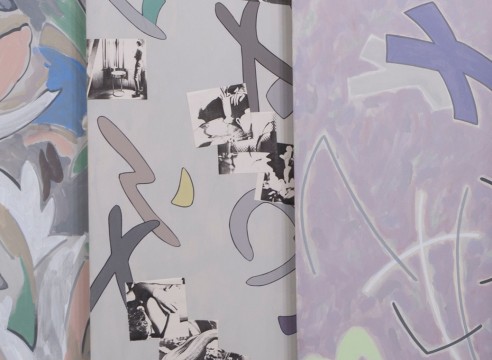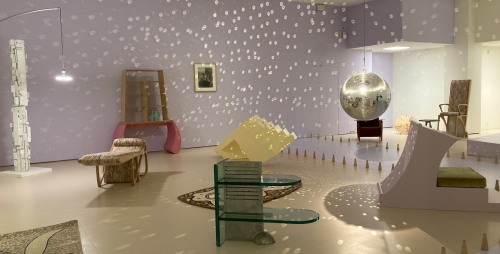

Starting from the Museum – its building, the industrial history of its area and its collections where art and design both found their place – the artist has conceived a conversation between more than eighty pieces he realized from the 1960s onwards and thirty works or so from the Museum’s collection. Chaimowicz unfolds those mixed artefacts within discreet dramas, between environments and interior designs, as sequences of a tailored screenplay: Zig Zag, Rachel et Graham, L’entrepôt, Peintures 1, Peintures 2, Du Textile, ...Many Ribbons.
The zig-zag quotes the exhibition’s title as well as the shape of architectural wall leading into the first gallery, the sewing machine 120 zigzag (1977) made by Manufrance, and the broken lines of Marie Tailhardat’s (the artist’s mother) sewing exercises when she worked as apprentice at Paquin, maison de haute couture, in Paris. As for the ribbons, they unroll, in an infinite way, the patterns Marc Camille Chaimowicz conceived in collaboration with Neyret, a century old firm from Saint-Étienne.
The work of Marc Camille Chaimowicz translates his practice, which draws a multiplicity of directions: for more than fifty years, he has been combining sculpture, performance, installation, architecture, painting, video, photography, and design in close relationship with all kinds of expertise deployed in fashion, textile, interior design. From the 1970s, the artist began to decorate his flat in London as if it were to make it his own in situ work. During those years, he claimed the private space as a building space for selfconstruction, against an environment felt to be alienating. Like a dreamed oasis, this fictitious space is deployed in his various exhibitions and shared with the viewer. Fabrics, screens, dressing tables, vases, consoles with pastel shades, whose formal repertoire that brings fruits, flowers and body parts in mind, confronted a social taboo, while the applied arts and house interiors were dismissed or regarded as feminine. Blurring the boundaries between art and design, raising the question of identity and genre, Marc Camille Chaimowicz has been turning the intimate into a political space.